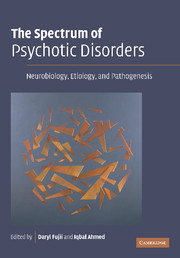Book contents
- Frontmatter
- Contents
- List of Contributors
- Preface
- Acknowledgements
- Part I Introduction
- Part II Primary Psychotic Disorders
- Part III Mood Disorders
- Part IV Neurodevelopmental and Genetic Disorders
- Part V Central Nervous System Disorders
- 13 Psychotic Disorder Due to Traumatic Brain Injury
- 14 Schizophrenia-Like Psychosis and Epilepsy
- 15 Psychosis following Cerebrovascular Accident
- 16 Psychosis in Patients with Brain Tumors
- 17 Psychosis Secondary to Infections
- 18 Psychosis Secondary to Inflammatory and Demyelinating Disease
- Part VI Substance Abuse and Medications
- Part VII Neurodegenerative Disorders
- Part VIII Sensory Impairments
- Part IX Conclusion
- Index
- References
16 - Psychosis in Patients with Brain Tumors
from Part V - Central Nervous System Disorders
Published online by Cambridge University Press: 06 January 2010
- Frontmatter
- Contents
- List of Contributors
- Preface
- Acknowledgements
- Part I Introduction
- Part II Primary Psychotic Disorders
- Part III Mood Disorders
- Part IV Neurodevelopmental and Genetic Disorders
- Part V Central Nervous System Disorders
- 13 Psychotic Disorder Due to Traumatic Brain Injury
- 14 Schizophrenia-Like Psychosis and Epilepsy
- 15 Psychosis following Cerebrovascular Accident
- 16 Psychosis in Patients with Brain Tumors
- 17 Psychosis Secondary to Infections
- 18 Psychosis Secondary to Inflammatory and Demyelinating Disease
- Part VI Substance Abuse and Medications
- Part VII Neurodegenerative Disorders
- Part VIII Sensory Impairments
- Part IX Conclusion
- Index
- References
Summary

- Type
- Chapter
- Information
- The Spectrum of Psychotic DisordersNeurobiology, Etiology and Pathogenesis, pp. 302 - 315Publisher: Cambridge University PressPrint publication year: 2007

